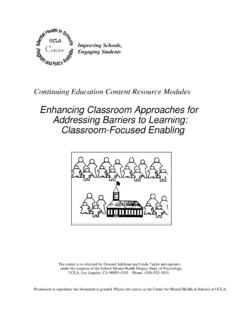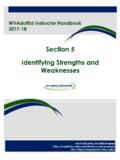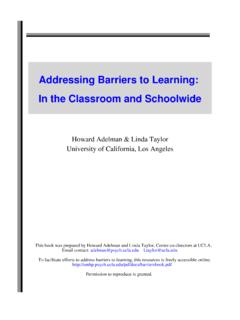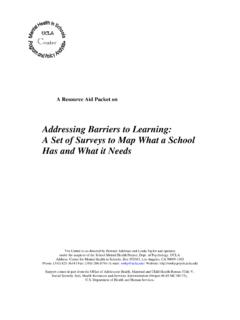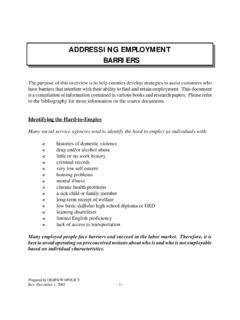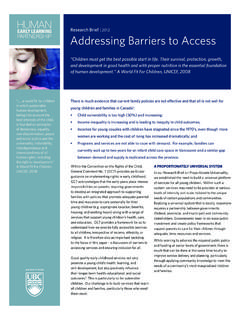Transcription of Addressing Barriers to Learning - files.eric.ed.gov
1 Addressing Barriers New ways to think .. to Learning Better ways to link Volume 13, Number 1 Winter, 2008 Challenges and Opportunities in the Classroom .. there's no bigger challenge than trying to insert kids in a one-size-fits-all [classroom] andthen having to deal with the spillover of emotional and behavioral reactions. If kids are not in aplace where they can learn, they let us know loud and clear. [Patricia Woodin-Weaver] Note: Effectively Addressing students behavior, Learning , and emotional problems requires greaterattention to transforming what transpires inclassrooms.
2 To this end, student support staff andothers who can help need to spend more timeteaming with teachers in the classroom. Tosupport such efforts, the Center has developedresources to enhance classroom practices foraddressing Barriers to Learning and teaching. Thisedition of our quarterly journal provides excerptsfrom a few of these resources. Response to Intervention initiatives stress theunacceptability of waiting for students to , as with so many other effortsconcerned with students Learning , behavior,and emotional problems, this budding movementmay become just another piecemeal approach.
3 Fragmentary endeavors cannot address the complexrealities confronting teachers and student supportstaff. A fact of life in too many classrooms is that asignificant proportion of students lack enthusiasmabout engaging in the day s lesson , a chilling number of students havebecome disengaged from classroom instruction, arebehaving in disruptive ways, and are dropping enable such student to succeed at school, staffmust enable them to (1) get around interferingbarriers and (2) re-engage in classroom designed, the response to interventionmovement can help, but it represents only one facetof what it takes to transform struggling classroomsinto effective Learning in battling Learning , behavior, andemotional problems probably can be achieved onlywhen school improvement policy, planning,implementation, and accountability expand to focuson developing a comprehensive system ofstudent/ Learning supports.
4 One major facet of sucha system involves enhancing a wide range ofregular classroom strategies to enable encompass: Opening the classroom door (a) to bring inmore help ( , volunteers trained to workwith students-in-need; resource teachers andstudent support staff to team up with theteacher in the classroom) and (b) to facilitatepersonalized professional development Ensuring what goes on in the classroom (andschool-wide) creates and maintains astimulating, caring, and supportive climate Redesigning classroom approaches toenhance teacher capability to prevent andhandle problems and reduce need for out ofclass referrals ( personalizing instruction.)
5 Expanding the range of curricular andinstructional options and choices; systematicuse of pre-referral interventions, response tointervention, and in class special assistance;turning big classes into smaller units;reducing over-reliance on social control)Opening the Classroom Door Opening the classroom door allows for many formsof assistance, mentoring, partnership, and othercollegial practices. Teachers, especially newteachers, need as much in-classroom support andpersonalized on-the-job education as can beprovided.
6 All teachers need to learn more about2how to enable Learning among students, especiallythose with problems. All school staff need supportfrom each other in enhancing outcomes for suchstudents. Given the shared agenda, it seems evidentthat staff not only should work closely with eachother, but also with parents, volunteers,professionals-in-training, and so forth. And, a largepart of the work should take place in the and teaming are key facets ofaddressing Barriers to Learning and teaching andpromoting engagement, Learning , performance, andhealthy development.
7 For instance, an openclassroom door allows student support staff to domuch more than consult with teachers ( , gobeyond just recommending what teachers should doabout student Learning , behavior, and emotionalproblems). But, before support staff can go intoclassrooms to team with teachers, they must learnmuch more about classroom life and , they must especially learn about what it takesto engage and re-engage students in classroominstruction. What follows is a brief introduction tothese , Caring, and Supportive Classrooms It is evident that how classrooms are arranged andhow instruction is organized helps or hinderslearning and teaching.
8 The ideal is to have anenvironment where students and teachers feelpositively stimulated, well-supported, and engagedin pursuing the Learning objectives of the engagement is especially important inpreventing problems. Thus, minimally, classroompractices must enhance motivation to learn byfacilitating active Learning in ways that promote anatmosphere of mutual caring and respect. Simply stated, active Learning is Learning by doing,listening, looking, and asking; but it is not justbeing active that counts.
9 It is the mobilization of thestudent to seek out and learn. Specific activities aredesigned to capitalize on student interests andcuriosity, involve them in problem solving andguided inquiry, and elicit their thinking throughreflective discussions and appropriate , the activities can be designed to do allthis in ways that minimize threats to and enhancefeelings of competence, self-determination, andrelatedness to others. There are many examples of ways to facilitateactive Learning at all grade levels.
10 It can take theform of class discussions, problem-based anddiscovery Learning , a project approach, involvementin Learning centers at school, experiences outsidethe classroom, and independent Learning in or out , caring, and supportive classrooms domuch more than motivate Learning of subject matterand academic skills. They provide conditions forsocial and emotional Learning . Students learn tocooperate, share responsibility, develop under-standing and skills related to conflict resolution andmediation, and much more.










